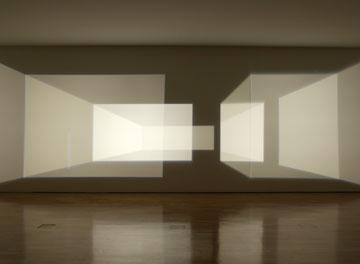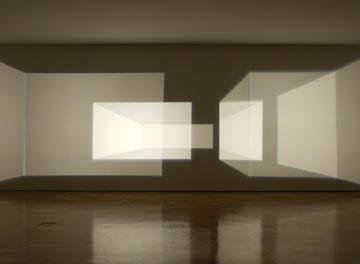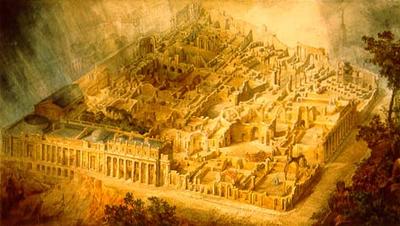While I was in Denver last week I picked up a copy of
The Myth of Solid Ground by David Ulin, which I read in a hotel on Denver's very odd – and very long – Quebec Street.
The book covers seismology, California's self-intersecting jigsaw puzzle of major and minor faultlines –

– and the imagination of disaster (to paraphrase Mike Davis); but it also explores (and, for the most part, debunks, though Ulin seems to do so only quite reluctantly)
earthquake sensitives, people who experience physical symptoms immediately prior to the onset of a quake. Headaches, back aches, bad dreams, aching joints – the body as a warning flag for terrestrial disturbance. The human nervous system as a seismic prediction device.
"Kathy Gori," for example, "a Los Angeles sensitive, has run off a string of better than twenty successful predictions – with just a handful of misses – by relying on headaches that come and go a few hours before a quake. The key, Gori believes, is that her brain contains higher-than-average levels of magnetite, the mineral that helps bats and other animals orient themselves to the electromagnetic field of the earth, which enables her to function as a tectonic receiver, as it were."
A tectonic receiver! Her brain, containing a metallic analogue of the earth's surface, responds to disturbances
in the earth's surface. The brain as a micro-landscape, metallized and resonating.
Or, more comically, there is the guy "nicknamed 'Pain-in-the-Butt Man,' because he feels pain shoot through his ass cheeks before the ground begins to shake."
So
that's what that was...
There's also "
Charlotte King, the self-styled doyenne of the earthquake sensitives," who claims that she "has literally been able to
hear low-frequency sound waves – a foghornlike moaning she refers to simply as 'The Sound' – and, in conjunction with physical symptoms ranging from anxiety and irritability to nosebleeds, muscle spasms, headaches, and severe stomach or heart pain, use them to predict earthquakes and volcanoes with a rate of accuracy that, by her accounting, comes in somewhere around 85 percent."
(Somewhat related to this, see BLDGBLOG's recent post on
Sound dunes).
On
Charlotte King's website there's even a definition of something she calls the "Charlotte King effect," aka "geosensology," or "the study of senses and biological systems as it relates to geologic dynamics or geologic events."
This – geosensology – is all part of
Project Migraine:
"Through the efforts of Charlotte King who pioneered Biological Earthquake Prediction, and Chris Dodge of the US Library of Congress, a volunteer research project was born – aptly named 'Project Migraine.' The focus of this project was to prove, beyond coincidence, that earthquakes and volcanic eruptions could be forecast, prospective of the event, giving time, magnitude, location and probability" – forecast using the human body.
King has mapped seemingly every part of her body to the earth's surface, limb by continent by island chain: "Upper back as I have repeatedly said is for Japan;" or "Pain in ears, this is usually Italy, Sicily, Greece and Crete." Her body – and this is not at all something I am endorsing, or implying that I believe – acts as a kind of muscular radio, or nervous antenna, the meat and gristle and bone of being human somehow tuned-in to geoseismic activity.
Earthquake/body/radio.
Ulin's book then looks at the scientific work of
Tony Fraser-Smith, a professor at Stanford University, "who recorded anomalous ultra-low-frequency (ULF) electromagnetic waves in the ground near Corralitos, a small town three miles from the Loma Prieta epicenter." (Loma Prieta was a large earthquake in 1989).
"'Twelve days before the earthquake,' he says, 'the noise level went up by a factor of ten. Three hours before, it went up by another factor of ten.'"
The faultlines themselves – all crushed rock and slurry –
were emitting radio waves.
This apparently legitimate discovery, however, collapes into the New Age weirdness of amateur earthquake prediction with a man called Jack Coles. Just after the Loma Prieta earthquake, "Fraser-Smith accompanied USGS seismologist Andy Michael to Coles's San Jose apartment, where they found [him] monitoring a symphony of static coming from an elaborate array of radios tuned between stations at the low end of the dial. 'Clearly,' Fraser-Smith remembers, 'he believed in what he was doing. I don't think he was a charlatan. But every time a radio popped, he'd claim it indicated something, which he'd then interpret according to his criteria that he wouldn't tell us anything about.'"
BLDGBLOG has already written about
radio astronomy; this, I suppose, is
radio seismology.
There are people who use clouds to predict earthquakes; there is even Jim Berkland, with his own method of prediction, "which is to read lost and found columns in various California newspapers," keeping "a daily log of pet disappearances in Los Angeles and the Bay Area, going back twenty-two years." (His earthquake prediction website can be found
here.)
The interest here, at least for me, is not the individual methods these people use, or even whether those methods can be treated as "scientific," but the basic idea at work behind them: that – through a kind of unintended revival of the medieval
Great Chain of Being – the human body, the lived skeleto-muscular present, is actually a
terrestrial analogue, a corporeal
mappa mundi. The idea that metal in the California hills can also be found in the human brain, thus making the human brain a microcosm or simulacrum of the earth: human anatomy as world model.
Yet it's also the seemingly disastrous misuse of hermeneutics – reading too far into things – that would lead someone to conclude that missing pet ads in Los Angeles newspapers are harbingers of earthquakes, or that radio static from dead stations hissing and popping outside the usable spectrum is somehow
coming from the earth, picking up on planetary reverberations, literally radio-active. Over-literalizing a pun.
The "earth" as a system of signs, meant to be interpreted. The logic behind this.
The logic of earthquake prediction.
(Meanwhile, for those of you dying to use origami as a means to analyze tectonic faulting, click
here).

















